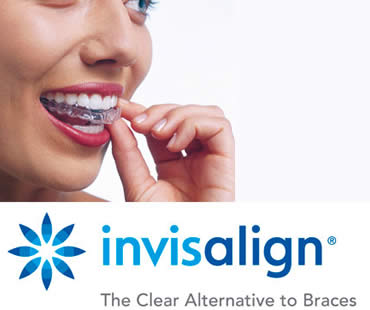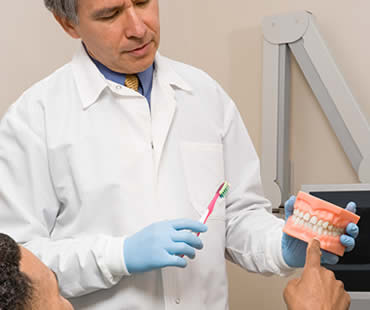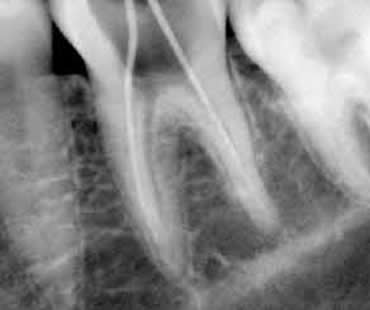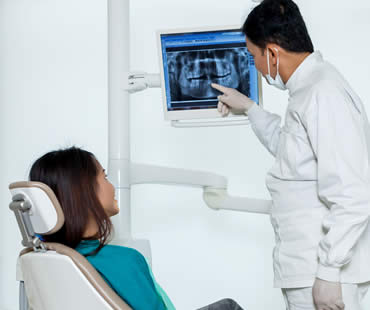
Apr 12, 2019
A new way to straighten teeth has been introduced with Invisalign clear braces. As you wear the invisible plastic aligners, your teeth are gently shifted into better positions and you avoid many of the hassles associated with traditional braces.
Treatment begins with a consultation with a professional who has been trained and recognized to provide Invisalign braces. A thorough analysis of your teeth and jaw, as well as your smile goals, will be done to determine if Invisalign is right for you. If so, a treatment plan will be customized just for you after X-rays and impressions of your mouth are taken. The process also uses 3D images to create a computer simulation of your treatment.
Using the exact measurements taken of your mouth, a set of aligners will be made from clear plastic. Invisalign treatment advances in stages, with a different set of aligners worn every two weeks. They should be worn consistently for about twenty hours daily, but are removable for eating and cleaning. Maintenance is simple because the aligners can be gently brushed along with your normal brushing routine.
There are no restrictions about foods to avoid when undergoing Invisalign treatment, since the aligners are removed while eating. You also don’t have to worry about food getting stuck in the braces like with metal braces, and because food doesn’t contact the aligners there are no worries about stains. Invisalign braces can be worn while playing instruments or sports, although they should not be considered a substitute for a protective mouth guard.
Visits to the orthodontist are usually required every six months or so to monitor treatment and ensure ideal results. The amount of time it takes to achieve your smile goals depends on each patient and how consistently the aligners are worn, but treatment often lasts about a year.
If you live in the Fall River area contact us today

Apr 5, 2019
Do you find yourself fading into the background at social events? Are you overlooked at meetings or in groups of people? Have you noticed that you don’t smile in photos? Are you uncomfortable eating, drinking or speaking because your teeth aren’t their best? Do you look at the beautiful smiles of those around you and wish you could have a similar smile?
When we meet someone for the first time, our smiles are often the first thing anyone notices. If your smile is less than its best, if it’s stained or unsightly, you could be making a bad first impression. These first impressions, whether valid or not, stick with people. A hesitant smile can signal low self-confidence or unhappiness. You could be projecting ill health or a lack of prosperity. Do you look friendly to others, or off-putting?
When you are confident about your smile, you can feel free to smile openly at others or for the camera. You can be more at ease about speaking up in public or at meetings at work. Don’t be stressed about that upcoming presentation or oral report. If you talk to your dentist today, you can begin enjoying the advantages a beautiful and bright smile can bring, beginning with your own self-confidence.
Talking to a cosmetic dentist can begin a path toward a short goal such as teeth whitening, or it can lead you to an orthodontist for alignment issues and orthodontia. Flaws such as cracks, chips or malformation can be easily corrected using resin composite materials. Larger problems such as tooth gaps or missing teeth can be corrected using dental implants or dental bridges. You might be suited for porcelain dental veneers for your therapy, or you may need a crown or two.
Your cosmetic dentist can help you plan for your dream smile. Your treatment might take one or two visits, or it might be ongoing, but beginning this smile makeover journey will never be something you regret. Begin enjoying the advantages a bright smile can bring you, both socially and professionally.
Schedule your appointment at our Fall River dental office

Mar 29, 2019
Wisdom teeth are the third set of molars and the last adult teeth to erupt into the mouth. Most people have four wisdom teeth, two on the bottom and two on top. Many people do not have enough room for these molars to emerge completely, causing them to become impacted in the gum. Impacted wisdom teeth are difficult to clean, making them more susceptible to decay and disease. Other dental problems caused by impacted wisdom teeth include pain, damage to surrounding teeth, and bite alignment issues. For these reasons, your dentist may recommend having the impacted teeth removed to prevent future problems.
Surgery to extract an impacted wisdom tooth or set of wisdom teeth is usually an outpatient procedure done in your dentist or oral surgeon’s office. If the tooth or surrounding area are deemed to have an infection prior to the procedure, surgery will be delayed, and your dental professional will likely prescribe antibiotics to help heal the area.
On the day of surgery, local anesthesia will be administered to numb the area where the extracted tooth will be removed. Depending on the severity of your case, your dentist or oral surgeon may also utilize a general anesthetic.
Once the anesthesia has taken effect, an incision will be made to open up the gum and any bone blocking the tooth will be removed. Your dentist or surgeon will then separate the tissue connecting the bone to the tooth and extract the tooth. Some teeth are too large to remove in one piece, in which case your surgeon will cut the tooth into smaller pieces to make it easier to remove. Finally, the incision is closed with stitches and packed with gauze to help alleviate bleeding.
Long-term complications from impacted wisdom tooth surgery are rare. To ensure a successful recovery from this or any oral surgery, be sure to follow all aftercare instructions provided by your dentist or oral surgeon.
Our dental office is located in Fall River

Mar 22, 2019
If you haven’t been to the dentist in a while, you may not recall the process for a regular checkup. These visits are an important part of your oral health care. If you are in good dental health, your dentist will probably suggest twice-yearly visits. Individuals with gum disease or other oral health concerns may need to schedule more frequent appointments. Feel free to ask your dentist questions or raise concerns at the visit.
Your dental checkup will usually include:
• Full Health History
Because oral health affects your overall wellness, your dentist will want to have a complete picture of your whole situation. A member of the dental team will ask you questions and gather relevant details about your present status. Make sure to provide helpful information like current medications and any pressing issues.
• X-Rays
Typically, your dentist will take X-rays about once a year. These images provide a clear view of your teeth and gums. Often, X-rays will identify problems, like impacted teeth, cysts, abscesses, or decay between teeth that might otherwise go undiagnosed.
• Complete Evaluation
During your checkup, the dentist will perform a periodontal assessment, bite analysis, and tooth-by-tooth inspection. If the dentist discovers a problem, your provider will make treatment recommendations to address the issue and restore your oral health.
• Thorough Cleaning
If everything checks out, the hygienist will typically remove plaque and tartar build-up from your teeth. At this time, the hygienist may also polish and floss teeth to refresh your smile.
Our dental office is located in Fall River

Mar 15, 2019
It’s part of life that your teeth will likely become dull and yellowed as you age and consume foods that contribute to teeth staining. However, you don’t have to go through life with a tainted smile. There are many options available these days for either at-home or professional teeth whitening. If you choose to brighten your smile, you’ll want to make sure you maintain the look as long as possible. Eating certain foods can help you naturally achieve the goal of a dazzling smile.
Citrus fruits:
Lemons, oranges, pineapples and other citrus fruits contain natural acids that help whiten teeth. Their tart flavor also promotes saliva in your mouth, which creates a natural rinse and polish over your teeth.
Strawberries:
Rich in vitamin C, strawberries can help prevent gum inflammation and other periodontal issues. They also contain malic acid as well as ellagitannins, which are antioxidants that help banish bacteria in your mouth.
Apples:
Chewing crunchy fruit like apples helps scrub your teeth to get rid of plaque and germs. Apples also have lots of malic acid, an ingredient in some toothpastes, which increases saliva to clean teeth and remove stains.
Pineapples:
An extra benefit of pineapples is bromelain, a compound that has cleansing and anti-inflammatory properties. It helps eliminate unsightly stains naturally.
Cheese:
Mineral ingredients like calcium and phosphorus give cheese an edge in strengthening your teeth. Cheese also contains protein that protects tooth enamel, and lactic acid that protects against tooth decay. Hard cheeses promote saliva production to clean your teeth.
Broccoli:
High in fiber, broccoli can help lower inflammation in your mouth and body. Crunching on raw broccoli cleans and polishes your teeth, and the iron content helps protect your teeth from damaging bacteria and acid.
Our dental office is located in Fall River

Mar 8, 2019
Most people would rather do anything than have a root canal. Unfortunately, this procedure receives a bad rap. A root canal is generally performed to clean out an infected tooth and prevent future problems. Usually, patients feel better after root canal therapy.
Knowing the truth about root canals may help you feel less apprehensive if your dentist recommends this procedure.
- A root canal hurts.
Actually, the pain you feel is caused by the swelling and pressure in your tooth. When a tooth sustains severe trauma, the pulp, or soft nerve center, may die. During a root canal, your dentist will remove the damaged tissue, disinfect the tooth, and seal off the inside. Most people only experience mild soreness afterwards, if they feel any discomfort at all.
- Root canal therapy takes many appointments.
Although this timing depends on the severity of the case, most root canals are completed in one to two appointments. Once your dentist finishes the root canal, you will probably need at least one more visit for restoration of the tooth, usually with an inlay, onlay, or crown.
- I only need a root canal if my tooth hurts.
Pain often lets you know you have a problem with a tooth, but if your tooth root dies you may have no symptoms. The dentist can perform tests to determine the health of a tooth, including temperature and percussion testing.
- The root canal won’t last.
Once the tooth is cleaned and sealed, you should have no further problems with the tooth. Sometimes the restoration of the tooth fails, which can causes the tooth to crack or break. This usually occurs if you wait too long to have a crown or adequate filling placed.
We look forward to seeing you in our Fall River dental office

Mar 1, 2019
Pain, sensitivity, and trouble eating or sleeping are only a few of the uncomfortable symptoms of a damaged tooth. Sometimes the inside portion of a tooth, or its pulp, becomes so damaged that action must be taken. It could come in the form of extracting the tooth or it might be able to be saved through root canal treatment.
Virtually every dentist recommends root canal therapy over tooth extraction. It’s almost always better to save your natural tooth. Otherwise, you’ll end up with a hole in your smile and the problems that accompany it.
A tooth can be damaged for a variety of reasons such as severe decay, trauma, or deep cavities. The damaged pulp contains nerves, which is one reason that many patients experience severe pain. Although dental fillings can remedy some cavities or decay, when the situation advances to the extent of harming the tooth pulp, fillings are not enough. Root canal treatment is usually the best way to repair the tooth without having to pull it.
A root canal procedure involves drilling into the tooth so that the pulp can be completely removed and the canal thoroughly cleaned. Then the area is filled with special material and sealed to prevent future damage. Often, a dental crown is placed on top of the restored tooth to provide added protection. This process alleviates any symptoms and give you back your fully functional, natural tooth.
If you were to opt for tooth extraction instead of root canal treatment, you’d be choosing a more invasive approach. The procedure can be intrusive, time consuming and costly. Recovery from tooth extraction can be uncomfortable and take longer than root canal therapy. Careful oral hygiene is necessary after extraction to avoid infection or complications. You’ll also be left with an unappealing hole in your smile that can make eating and speaking more difficult, and your other teeth will likely start moving into that empty space.
To determine the best treatment for you, consult a reputable dentist. You’ll learn about the options and how root canal therapy may be the best choice in restoring your oral health and your smile.
We look forward to seeing you in our Fall River dental office

Feb 22, 2019
Are you looking to improve your smile but you don’t have a lot of time? Have you heard that smile makeovers are invasive and time-consuming? There are many options available to you for your smile makeover that are relatively short and sweet. If you are in good health but want to make improvements to your smile, these fast and easy options may be right for you.
Teeth bleaching (also known as whitening) is an extremely popular and very simple therapy for quickly brightening your smile. Many common foods and drinks we consume daily can slowly dim your smile by discoloring or staining your tooth enamel. Having your teeth whitened by your dentist can lighten your teeth by as many as ten levels in a single office visit, saving you time and effort.
Composite bonding can repair small problems like cracks, chips or irregular shapes in one visit. Bonding is done by hand by your dentist and requires excellent technique and materials, as well as the skill needed to match your natural tooth color.
Perhaps you need a little more extensive work done to achieve your dream smile, but you don’t have the time. Your dentist may be able to offer you a “snap-on” smile. This is a thin appliance that is placed on top of your natural teeth using nothing but your teeth as an anchor – no adhesives are necessary. These snap-on teeth can be made to mimic a celebrity’s teeth, or just better, straighter, whiter versions of your own. They can stay in all day during your regular activities, allowing you to get the benefits of a beautiful smile without the time of a more invasive treatment.
Talk to your dentist today about the treatments you can have done in a single office visit. Your friends, family and coworkers might not be able to immediately identify what “work” you had done, but you can rest assured everyone will notice your change in attitude and your gorgeous smile.
If you live in the Fall River area contact us today

Feb 15, 2019
Everyone knows that tobacco is harmful to your health, but many people believe that smokeless tobacco doesn’t fall into the same category. Just because it’s smokeless doesn’t mean it’s harmless. It’s dangerous for your overall health, but also for your oral health. Here are some possible oral health outcomes of using smokeless tobacco.
Tooth decay
Smokeless tobacco contains sugar, which combines with the plaque on your teeth to damage your tooth enamel and cause decay.
Receding gums
Placing chewing tobacco in your mouth at the same spot over and over can permanently damage your gums. It can also harm your bone structure. Your irritated gums may pull away from your teeth, expose your tooth roots, and leave your teeth painful and susceptible to decay. Receding gums sometimes also loosen your teeth and cause them to eventually fall out.
Tooth discoloration
Smokeless tobacco stains your teeth, causing embarrassing yellow and brown discoloration. It is extremely difficult to remove with normal brushing, and even professional teeth whitening may not completely remove these stubborn stains.
Bad breath
Your breath will suffer from tobacco products of any kind. Don’t be fooled into thinking that mint-flavored smokeless tobacco hides the problem.
Tooth abrasion
Smokeless tobacco can be gritty and scratch your teeth, wearing down the enamel. Loss of tooth enamel increases sensitivity and may require treatment.
Cancer
The consistent placement of tobacco inside your gums and the irritating juices accompanying it can cause a pre-cancerous condition called leukoplakia. All smokeless tobacco contains cancer-causing agents, which subject users to higher cancer risk in the oral cavity, larynx, esophagus, and pharynx.
We treat patients from Fall River and the surrounding area

Feb 8, 2019
What is a dental bridge?
- Dental bridges make a bridge between two anchor teeth and are meant to fill a space left by a missing tooth. Teeth can be missing due to trauma, decay or some type of natural loss. Dental crowns cap the anchor teeth, giving the bridge stability and giving the replacement tooth the strength to function as a natural tooth.
What is a dental crown?
- Dental crowns are a restorative treatment meant to protect a tooth that has gone bad due to cracking, acute decay, or has received root canal therapy. A crown is crafted to fit in your mouth and to function exactly as your natural tooth would. They work by covering the damaged tooth entirely and can change the shape or alignment of the prior natural tooth.
Isn’t a dental crown the same thing as a dental cap?
- A dental cap and a dental crown are two different terms for the same thing.
What are dental crowns made of?
- Dental crowns can be made of 100% ceramic (porcelain), porcelain-fused-to-metal, or gold or other metal alloy, including zirconia. Metal alloy dental crowns are typically stronger and more suited for back teeth.
Do dental crowns look natural?
- Crowns made from porcelain or ceramic can be very natural looking. Many materials have excellent translucency, and mimic your natural teeth very well.
Is a dental bridge an option for me?
- Are you missing a tooth? Are your adjacent teeth healthy and stable? If so, dental bridge treatment may be right for you.
Are there options available to me other than dental bridges to replace missing teeth?
- The best alternative option to replace a missing tooth is a dental implant. Dental implants can restore one or more teeth by being placed directly into the jawbone, fusing securely over time.
If you’re considering moving forward to replace your missing tooth or teeth, discuss options with your cosmetic dentist. Get the answers you need to determine if dental crowns or dental bridges can help you reach your smile goals.
We treat patients from Fall River and the surrounding area










